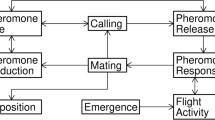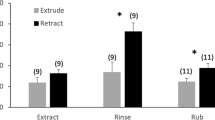Abstract
Quiescent male gypsy moths (Lymantria dispar) exposed in a wind tunnel to either pulsed (0.5-, 2- or 5-sec on, followed by a two-fold time interval off) or continuous streams of synthetic pheromone responded similarly in the proportions and latencies of wing fanning. Similarly, upwind anemotactic flight tracks in pulsed (1-sec on and 1-sec off) and continuous plumes of pheromone were indistinguishable. These data suggest that in the gypsy moth (1) pulsed pheromone stimuli would not lower the threshold, despite the improvement in the signal-to-noise ratio; and (2) temporal modulation of the pheromone plume at 1-sec intervals does not alter the “preprogrammed” upwind flight pattern.
Similar content being viewed by others
References
Aylor, D.E., Parlange, J.-Y., andGranett, J. 1976. Turbulent dispersion of disparlure in the forest and male gypsy moth response.Environ. Entomol. 5:1026–1032.
Baker, T.C., andCardé, R.T. 1978. Disruption of gypsy moth male sex pheromone behavior by high frequency sound.Environ. Entomol. 7:45–52.
Bossert, W.H. 1968. Temporal patterning in olfactory communication.J. Theor. Biol. 18:157–170.
Bossert, W.H., andWilson, E.H. 1963. The analysis of olfactory communication among animals.J. Theor. Biol. 5:443–469.
Cardé, R.T., andRoelofs, W.L. 1973. Temperature modification of male sex pheromone response and factors affecting female calling inHolomelina immaculata (Lepidoptera: Arctiidae).Can. Entomol. 105:1505–1512.
Cardé, R.T., andHagaman, T.E. 1979. Behavioral responses of the gypsy moth in a wind tunnel to air-borne enantiomers of disparlure.Environ. Entomol. 8:475–484.
Cardé, R.T., andHagaman, T.E. 1983. Influence of ambient and thoracic temperatures upon sexual behaviour of the gypsy moth.Physiol. Entomol. 8:7–14.
Conner, W.E., Eisner, T., Vander Meer, R.K., Guerrero, A., Ghiringelli, D., andMeinwald, J. 1980. Sex attractant of an arctiid moth (Utethesia ornatrix): A pulsed chemical signal.Behav. Ecol. Sociobiol. 7:55–63.
Elkinton, J.S.,Cardé, R.T., andMason, C.J. 1984 Evaluation of time-average dispersion models for estimating pheromone concentration in a deciduous forest.J. Chem. Ecol. (in press).
Falco, R.E. 1980. Combined simultaneous flow visualization and hot-wire anemometry for the study of turbulent air flows.J. Fluids Eng. 102:174–182.
Hagaman, T.E., andCardé, R.T. 1984. Effect of pheromone concentration on the organization of pre-flight behaviors of the male gypsy moth,Lymantria dispar.J. Chem. Ecol. 10:17–23.
Kennedy, J.S., Ludlow, A.R., andSanders, C.J. 1980. Guidance system used in moth sex attraction.Nature 288:475–477.
Marsh, D., Kennedy, J.S., andLudlow, A.R. 1978. An analysis of anemotactic zigzagging flight in male moths stimulated by pheromone.Physiol. Entomol. 3:221–240.
Murlis, J., andJones, C.D. 1981. Fine-scale structure of odour plumes in relation to insect orientation to distant pheromone and other attractant sources.Physiol. Entomol. 6:71–86.
Potter, M.C., andFoss, J.F. 1975.Fluid Mechanics. John Wiley & Sons Inc., New York.
Wright, R.H. 1958. The olfactory guidance of flying insects.Can. Entomol. 90:81–89.
Author information
Authors and Affiliations
Additional information
Journal paper No. 10916 of the Michigan State University Agricultural Experiment Station.
Rights and permissions
About this article
Cite this article
Cardé, R.T., Dindonis, L.L., Agar, B. et al. Apparency of pulsed and continuous pheromone to male gypsy moths. J Chem Ecol 10, 335–348 (1984). https://doi.org/10.1007/BF00987861
Received:
Revised:
Issue Date:
DOI: https://doi.org/10.1007/BF00987861




